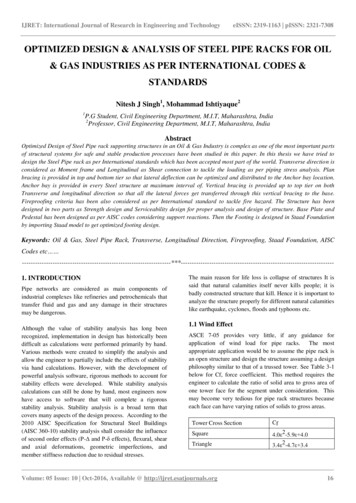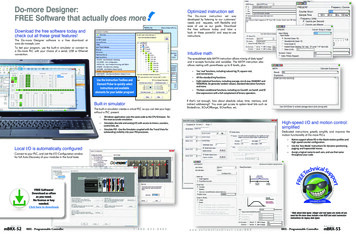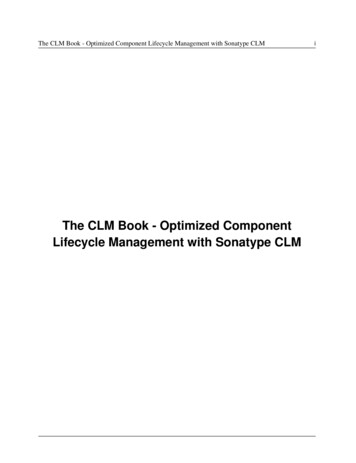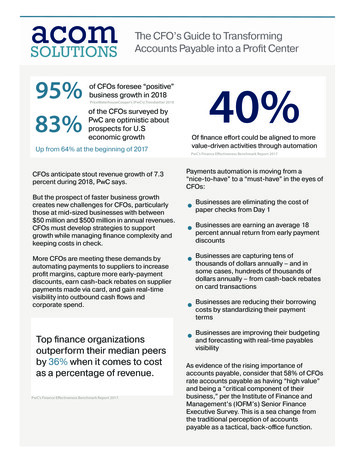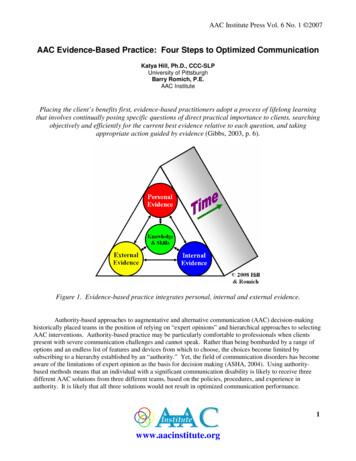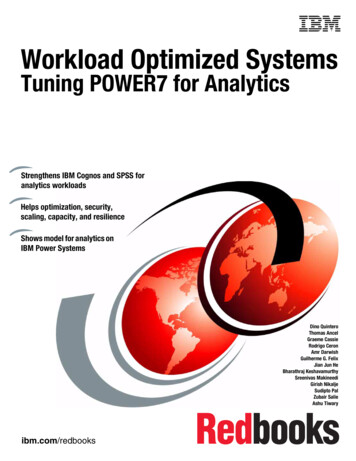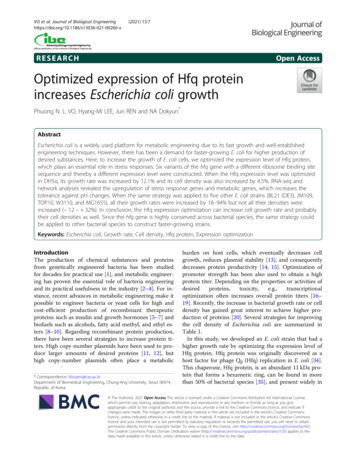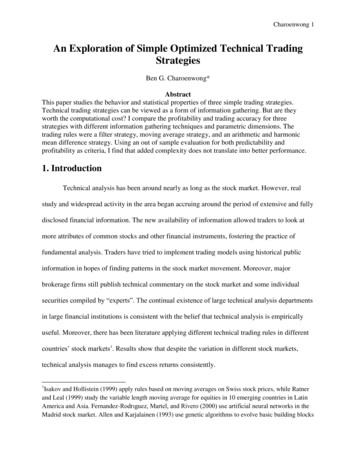
Transcription
Charoenwong 1An Exploration of Simple Optimized Technical TradingStrategiesBen G. Charoenwong*AbstractThis paper studies the behavior and statistical properties of three simple trading strategies.Technical trading strategies can be viewed as a form of information gathering. But are theyworth the computational cost? I compare the profitability and trading accuracy for threestrategies with different information gathering techniques and parametric dimensions. Thetrading rules were a filter strategy, moving average strategy, and an arithmetic and harmonicmean difference strategy. Using an out of sample evaluation for both predictability andprofitability as criteria, I find that added complexity does not translate into better performance.1. IntroductionTechnical analysis has been around nearly as long as the stock market. However, realstudy and widespread activity in the area began accruing around the period of extensive and fullydisclosed financial information. The new availability of information allowed traders to look atmore attributes of common stocks and other financial instruments, fostering the practice offundamental analysis. Traders have tried to implement trading models using historical publicinformation in hopes of finding patterns in the stock market movement. Moreover, majorbrokerage firms still publish technical commentary on the stock market and some individualsecurities compiled by “experts”. The continual existence of large technical analysis departmentsin large financial institutions is consistent with the belief that technical analysis is empiricallyuseful. Moreover, there has been literature applying different technical trading rules in differentcountries’ stock markets1. Results show that despite the variation in different stock markets,technical analysis manages to find excess returns consistently.1Isakov and Hollistein (1999) apply rules based on moving averages on Swiss stock prices, while Ratnerand Leal (1999) study the variable length moving average for equities in 10 emerging countries in LatinAmerica and Asia. Fernandez-Rodrıguez, Martel, and Rivero (2000) use artificial neural networks in theMadrid stock market. Allen and Karjalainen (1993) use genetic algorithms to evolve basic building blocks
Charoenwong 2The advent of the efficient market hypothesis proposed by Fama (1965) was followedwith a flurry of papers claiming that technical analysis is not profitable. Later, Samuelson (1965)and Fama (1970) stated that simulated trading results are in a sense a test of market efficiency.The hypothesis states that the price of stocks is a representation of all current information, so anymovement cannot be predicted systematically. However, another group of studies related to thiswork show evidence of excess returns in strategies derived from past returns.Research in trading strategies was popular from the 1960s and then again in early 2000s.Various papers found profitable trading strategies, attributing possible reasons to the non-linearsemi-structured nature of the stock market, information asymmetry, and investor psychology.Brock, Lakonishok, and LeBaron (1992) claim that perhaps the excess returns over the buy andhold strategy to the simplistic and possibly inaccurate measure of volatility as the standarddeviation of the return and lack of an accurate asset pricing model. In other words, if there were abetter asset pricing model or measure of risk, the “excess” returns may disappear accordingly.An investor, seeking to make a profit in the market, should consider between a randomwalk model and a more complex model a degree of dependence. Fama and Blume (1966) presentthe idea that in a random-walk market with or without a positive drift, no technical trading ruleapplied to a single security will consistently outperform the buy and hold strategy. Developingalternative models to the fair market hypothesis involves dedicating a fair amount of resources.Therefore, if the actual degree of dependence cannot be systematically optimized to generateexcess returns over the buy and hold strategy, the investor should stick with the buy and holdpolicy.of technical analysis into more complex algorithms applied to the S&P Composite Index.*Charoenwong worked under the supervision of Professor Edward Rothman of the Statistics Departmentin the University of Michigan.
Charoenwong 3Technical trading strategies are algorithms that take inputs regarding the stock market,and outputs a decision, whether to buy or sell a stock for a given time period. Academic interestin testing technical analysis dates back to the 1960s. Early studies focused primarily on simpletrading rules. There is an abundance of literature finding profitability in technical tradingstrategies using complex statistical tools and machine learning techniques. JS Liao and PY Chen(2001) develop a learning classifier system to adapt to changing market environments under theassumption that the stock market is semi-structured, non-linear and non-stationary. Potvin,Soriano and Vallee (2004) propose genetic programming as a means to automatically generateshort term trading rules to exploit short term fluctuations in price, and O’Neill, Brabazon, Ryanand Collins (2001) introduce grammatical evolution as an improvement over works that usedgenetic algorithms. As more financial data becomes readily available, these techniques can beimplemented to try to extract any meaningful information from the stock market. Though themachine learning techniques may not offer a theoretical explanation to the behavior of the stockmarket, the existence of systematic profits or losses may point out interesting patterns to beexplored in financial theory. The techniques for discovering possibly hidden relationships instock returns range from extremely simple to quite elaborate.Another perspective is that technical trading strategies could also be considered asinformation gathering. Grossman and Stiglitz (1980) suggested that the traditional interpretationof market efficiency provided by Fama (1965) is flawed. If prices fully reflected information inthe market, then investors who expend resources to gather information should be making a lossexactly equal to the cost of gathering the information. However, if nobody gathers costlyinformation, then it cannot be reflected in prices. Therefore, there must be an award of sorts forexpending the resources in the first place. Since the cost of information gathering is not
Charoenwong 4accounted for model of fair returns, there will seem to be excess returns. If the cost of acquiringthe additional information, whatever form it may be in, is accounted for, then the excess returnsshould disappear. The excess returns should be equal to the cost of acquiring informationthrough technical analysis. In this view, the excess returns first shown by Brock, Lakonishok andLeBaron (1992) and later on by many others are consistent with market efficiency. However, ifthis claim were true, as data become cheaper to acquire, store and distribute and computersbecome more powerful, the cost of obtaining technical information should decrease. Since thecost of acquiring information decreases, the excess returns should also decrease. This study doesnot pay particular attention to this hypothesis. Though not rigorously tested in this study, anexpected trend should emerge.If excess returns persist through time despite the availability of data, it may be morelikely that other factors are accountable for the apparent inefficiency of the stock market. Atrading strategy that produces a consistent profit (or loss) may contain predictive power. Thestrategies are optimized for profits initially through both the Newton-Rhapson algorithm usingnumerical approximations to the gradient and hessian, and the one dimensional algorithm nativeto the statistical program R. All strategies are in comparison to the buy and hold strategy dictatedby the efficient market hypothesis. The strategies that were tested are a modified filter strategy, amoving average strategy, and a comparison of arithmetic and harmonic means for prices. Thefirst two are momentum based strategies and work based on positive correlation between thestock price and its first lag.Using daily data allows for more variation in the stock price. If there are morefluctuations in the data, there are more potential optimal times to buy and sell stocks. Though thestock market may have shown a persistent long term growth trend, in the short term the price
Charoenwong 5behavior of stocks is very noisy. Therefore, active strategies should be more profitable in theshort term with more variation than the long term, since there is more possibility that the stockmay be ‘mispriced’ according to the criteria for each strategy.The technical trading strategies used in this study are both a combination of filter andtrend based. Filter strategies indicate a buy and sell when the price falls above or below aspecific percentage of a combination of past prices. An example of this strategy would be to buya stock if it has increased by 3% or more in the past day. Trend based produce a buy and sellsignal as a result of the cross of current prices and past prices. An example of this strategy wouldbe to sell a stock if it has dropped below the 3 day low and moving average.The paper will discuss the data used in the study and then go over the methodology. Afterthat, all of the strategies used are presented in their entirety, from their development to whetherthe strategies remain in use today and why. The strategies implemented in this study also allowthe plausibility of small investors to use technical trading strategies for profit.2. DataTechnical trading strategies can also be applied to any type of financial instrument. Dueto the theoretical obscurities financial derivatives, this study only focuses on equities. Because ofthe complex supply and demand dynamics of different industries, this study narrows down on theS&P 500 Total Return Index. Also, the profitability of technical trading strategies in an indexrepresentative of the stock market are more readily interpreted in a macroeconomic condition.Using a representation of the entire stock market does not subject the time series to adirectional drift that may be present in an index segmented by market capitalization. The stockindex attempts to create a representation of the entire stock market. A committee selects thestocks to be included, though it is not through a strict rules-based decision like the Russell 1000.
Charoenwong 6Moreover, only stocks of publicly traded companies and those with sufficient liquidity areincluded in the index. The S&P 500 Total Return Index also accounts for dividends paid out bythe different companies held in the index.Because dividends can be considered as a kind of returns on top of capital gains, thestudy generates strategies based on the adjusted close price of the S&P 500. The ex-dividenddays’ prices are adjusted by adding back the dividend. This helps to ensure that the price seriesdoes not drop move periodically simply due to the existence of the dividends and generatemisleading results. If the dividends were not factored in, then there would be a periodic drop inthe price (theoretically the drop is exactly the amount of the dividend). Technical trading rulesmay pick up on this trend and attempt to generate profits by buy on ante-dividend days. Inreality, there was no real shift in the value of the stocks since they were simply discounted by thedividend. Trading rules that act on this false signal would generate expected negative returnsexactly equal to the trading cost.The interday strategies are optimized for the S&P 500 index using the close of everytrading day since January 3, 1950 to September 30, 2011 while for the Vanguard 500 the dataranged from March 27, 1987 to September 30, 2011. The dates included in this study are all thehistorical data readily available on Yahoo! Finance. The data contains multiple shocks andrecession periods that should provide a large enough sample to generate robust strategies thatproduce long term excess profits as opposed to short term profits that do not necessarily exploitany possible trends in the stock prices.
Charoenwong 73. Technical Trading Rules3.1Filter StrategiesFilter strategies are a set of straightforward rulesConditionDecisionbased on price momentum that decide whether to buy orsell a stock after it has risen or dropped a certainBuy/Holdpercentage. An x percent filter strategy is defined asfollows: If the percentage changes of price from time t-1Sell/Stay Outto t is greater than x percent, buy and hold the security until it drops at least x percent. Typically,these benchmarks are simply the previous day’s closing prices. Alexander (1961) formulated thefilter strategy to test the hypothesis that the stock market adjusts gradually to new information.Alexander studied filters ranging from 5 percent to 50 percent for the periods 1897 to 1959involving two indices: the Dow-Jones Industrials from 1897 to 1929 and the Standard and Poor’sIndustrials from 1929 to 1959. He found profits significantly greater than the simple buy andhold strategy. Extending his study, Fama and Blume (1966) studied filter strategies ranging from0.5% to 50% in the Dow-Jones Industrial Average from different initial dates centering aroundthe end of 1957 to September 26, 1962.The belief is that there is a specific value that would consistently generate excess profit.This is equivalent to claiming that if the stock market rises x percent, it should raise by morethan x percent until it decreases by x percent. The underlying notion of buying when the priceincreases by x percent is that there is a lag in investors’ reactions to new information. However,because of the reasons provided in the motivation of this study, as information disseminatesquickly, we should see the excess profits from this strategy decrease. It is important to po
short term trading rules to exploit short term fluctuations in price, and O’Neill, Brabazon, Ryan and Collins (2001) introduce grammatical evolution as an improvement over works that used genetic algorithms. As more financial data becomes readily available, these techniques can be implemented to try to extract any meaningful information from the stock market. Though the machine learning .


